EDU101: An Analysis of Educational Theories, Principles, and Models
VerifiedAdded on 2020/10/05
|13
|3917
|277
Report
AI Summary
This report provides a comprehensive analysis of various theories, principles, and models relevant to education and training. It begins by exploring learning theories such as behaviorism, cognitivism, and humanism, along with learning models like Kolb's and Dunn & Dunn, and discusses their application in teaching and assessment. The report then delves into communication theories, including persuasion and social learning theories, and models like linear and interactive models, emphasizing their role in effective teaching. Furthermore, it examines assessment theories, including formative and summative assessment, and explores curriculum development principles. Finally, the report analyzes the theories, principles, and models of reflection and their application in reviewing teaching practices, offering insights into how these elements contribute to a robust and effective educational approach. The report highlights the importance of understanding learner preferences and adapting teaching methods accordingly. The report concludes by emphasizing the importance of effective communication, assessment, and curriculum development in creating a conducive and inclusive learning environment.
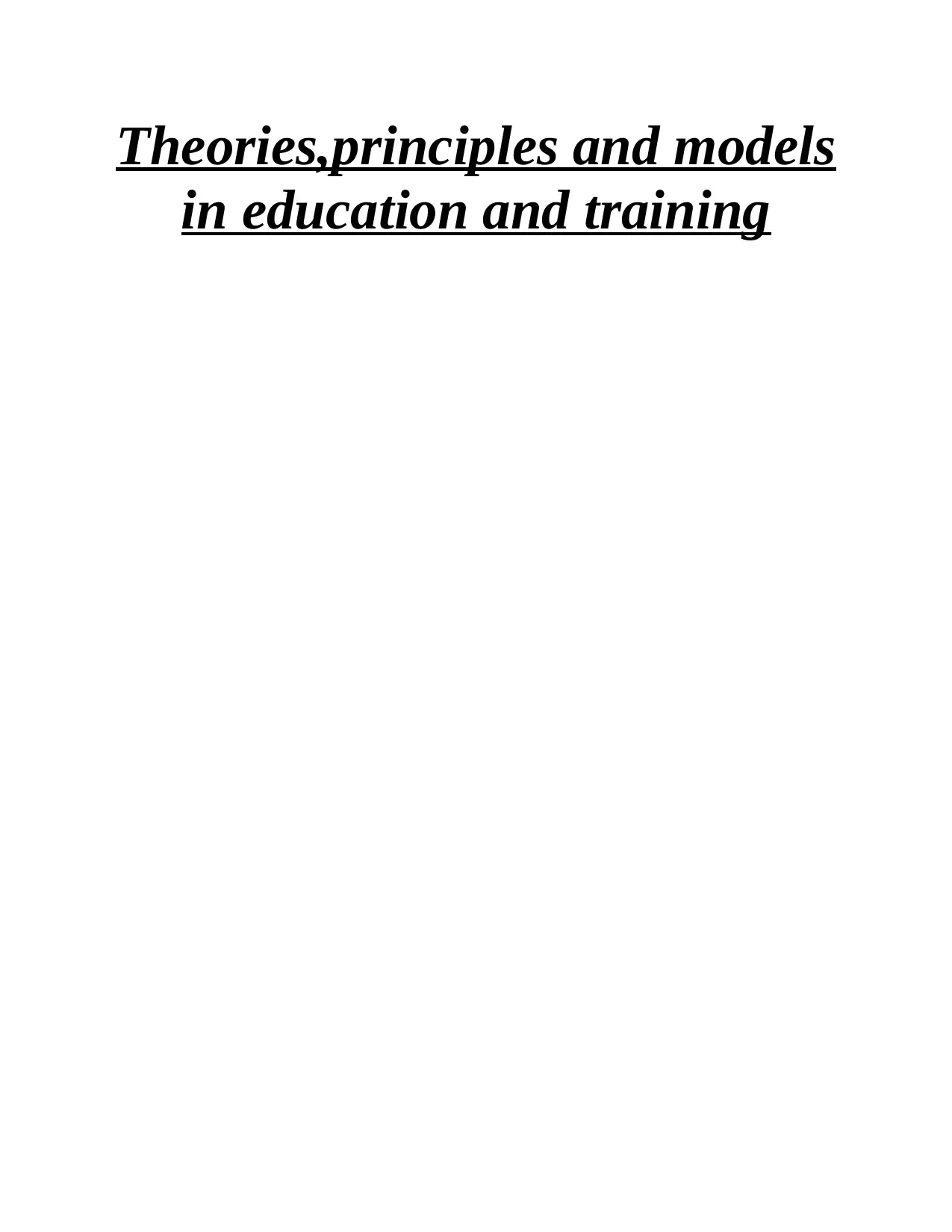
Theories,principles and models
in education and training
in education and training
Paraphrase This Document
Need a fresh take? Get an instant paraphrase of this document with our AI Paraphraser
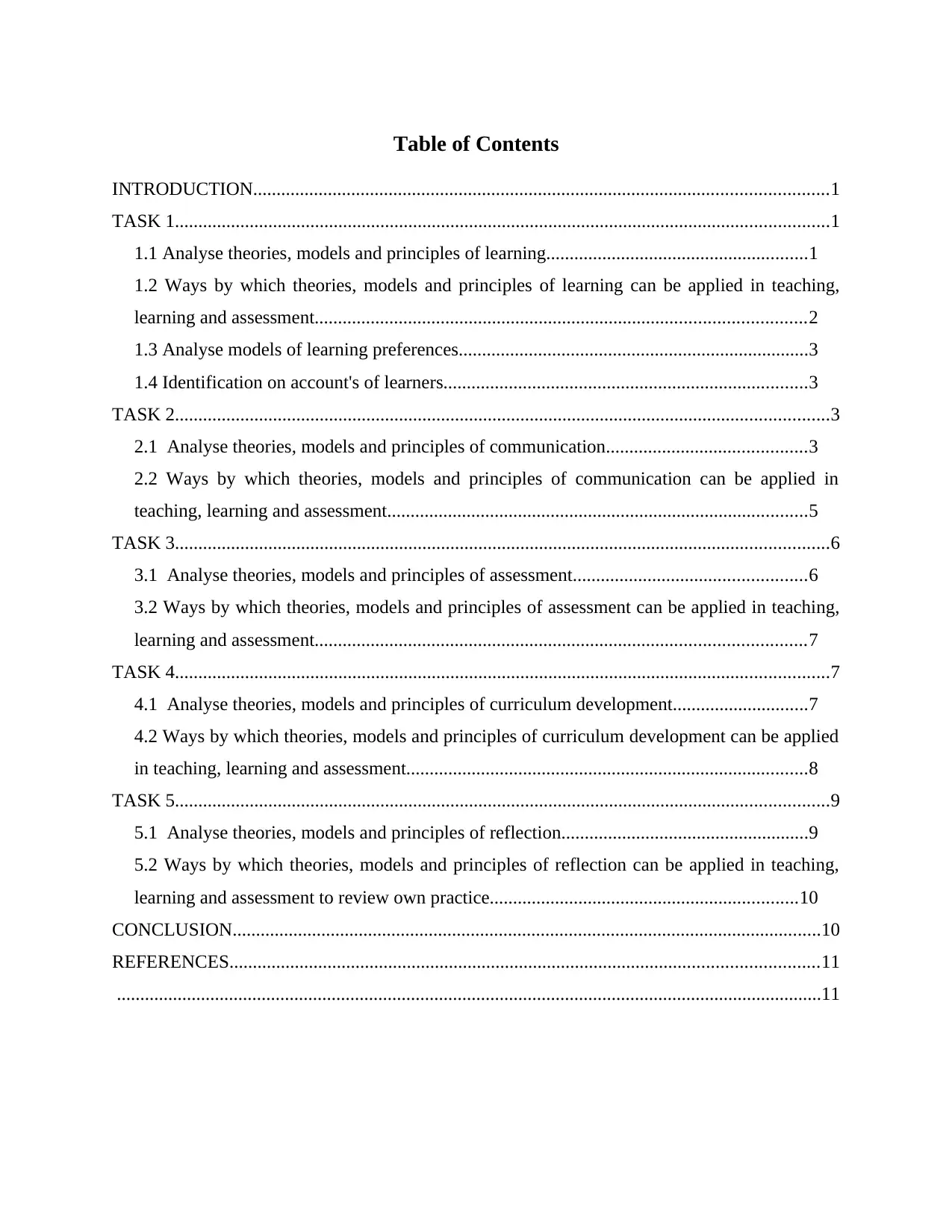
Table of Contents
INTRODUCTION...........................................................................................................................1
TASK 1............................................................................................................................................1
1.1 Analyse theories, models and principles of learning........................................................1
1.2 Ways by which theories, models and principles of learning can be applied in teaching,
learning and assessment.........................................................................................................2
1.3 Analyse models of learning preferences...........................................................................3
1.4 Identification on account's of learners..............................................................................3
TASK 2............................................................................................................................................3
2.1 Analyse theories, models and principles of communication...........................................3
2.2 Ways by which theories, models and principles of communication can be applied in
teaching, learning and assessment..........................................................................................5
TASK 3............................................................................................................................................6
3.1 Analyse theories, models and principles of assessment..................................................6
3.2 Ways by which theories, models and principles of assessment can be applied in teaching,
learning and assessment.........................................................................................................7
TASK 4............................................................................................................................................7
4.1 Analyse theories, models and principles of curriculum development.............................7
4.2 Ways by which theories, models and principles of curriculum development can be applied
in teaching, learning and assessment......................................................................................8
TASK 5............................................................................................................................................9
5.1 Analyse theories, models and principles of reflection.....................................................9
5.2 Ways by which theories, models and principles of reflection can be applied in teaching,
learning and assessment to review own practice..................................................................10
CONCLUSION..............................................................................................................................10
REFERENCES..............................................................................................................................11
.......................................................................................................................................................11
INTRODUCTION...........................................................................................................................1
TASK 1............................................................................................................................................1
1.1 Analyse theories, models and principles of learning........................................................1
1.2 Ways by which theories, models and principles of learning can be applied in teaching,
learning and assessment.........................................................................................................2
1.3 Analyse models of learning preferences...........................................................................3
1.4 Identification on account's of learners..............................................................................3
TASK 2............................................................................................................................................3
2.1 Analyse theories, models and principles of communication...........................................3
2.2 Ways by which theories, models and principles of communication can be applied in
teaching, learning and assessment..........................................................................................5
TASK 3............................................................................................................................................6
3.1 Analyse theories, models and principles of assessment..................................................6
3.2 Ways by which theories, models and principles of assessment can be applied in teaching,
learning and assessment.........................................................................................................7
TASK 4............................................................................................................................................7
4.1 Analyse theories, models and principles of curriculum development.............................7
4.2 Ways by which theories, models and principles of curriculum development can be applied
in teaching, learning and assessment......................................................................................8
TASK 5............................................................................................................................................9
5.1 Analyse theories, models and principles of reflection.....................................................9
5.2 Ways by which theories, models and principles of reflection can be applied in teaching,
learning and assessment to review own practice..................................................................10
CONCLUSION..............................................................................................................................10
REFERENCES..............................................................................................................................11
.......................................................................................................................................................11
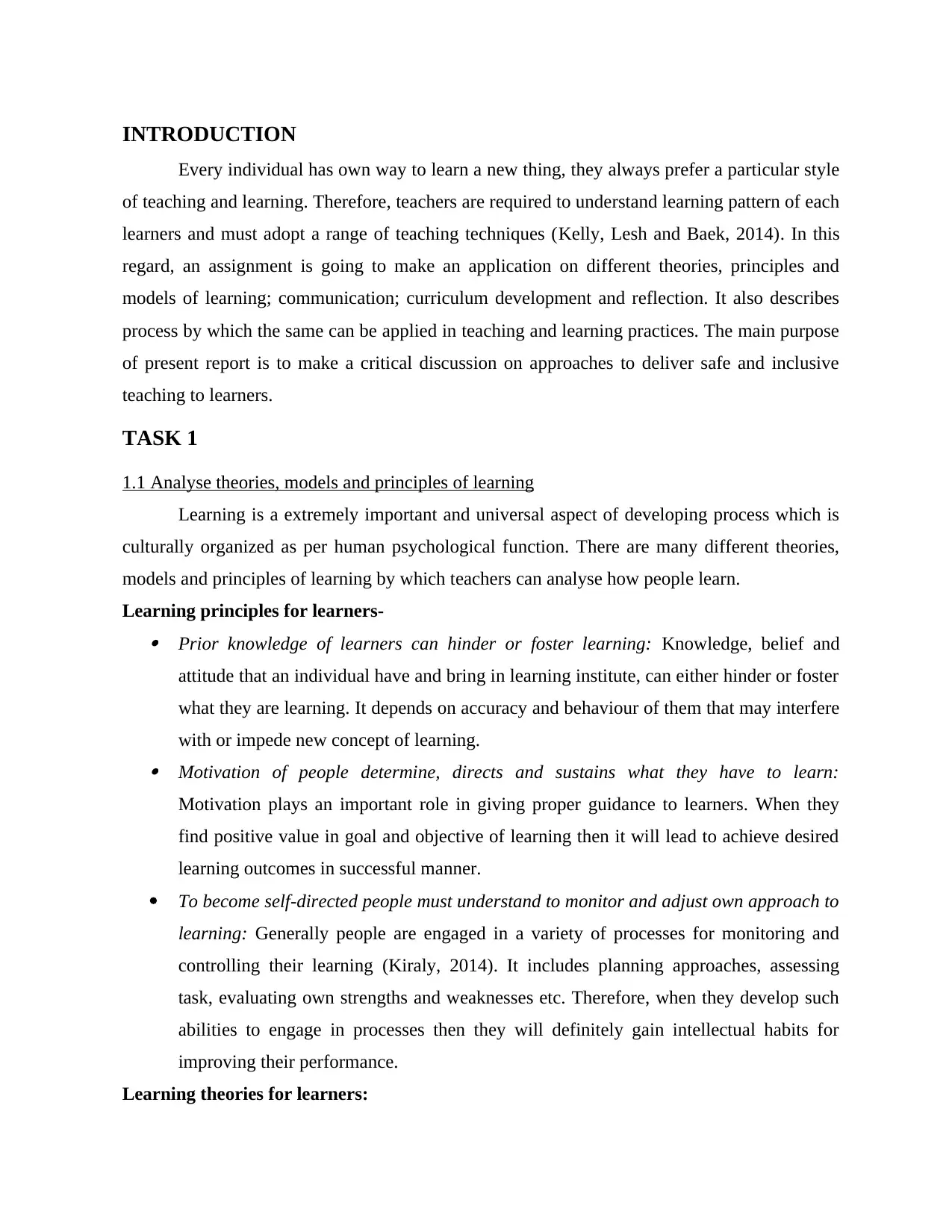
INTRODUCTION
Every individual has own way to learn a new thing, they always prefer a particular style
of teaching and learning. Therefore, teachers are required to understand learning pattern of each
learners and must adopt a range of teaching techniques (Kelly, Lesh and Baek, 2014). In this
regard, an assignment is going to make an application on different theories, principles and
models of learning; communication; curriculum development and reflection. It also describes
process by which the same can be applied in teaching and learning practices. The main purpose
of present report is to make a critical discussion on approaches to deliver safe and inclusive
teaching to learners.
TASK 1
1.1 Analyse theories, models and principles of learning
Learning is a extremely important and universal aspect of developing process which is
culturally organized as per human psychological function. There are many different theories,
models and principles of learning by which teachers can analyse how people learn.
Learning principles for learners- Prior knowledge of learners can hinder or foster learning: Knowledge, belief and
attitude that an individual have and bring in learning institute, can either hinder or foster
what they are learning. It depends on accuracy and behaviour of them that may interfere
with or impede new concept of learning. Motivation of people determine, directs and sustains what they have to learn:
Motivation plays an important role in giving proper guidance to learners. When they
find positive value in goal and objective of learning then it will lead to achieve desired
learning outcomes in successful manner.
To become self-directed people must understand to monitor and adjust own approach to
learning: Generally people are engaged in a variety of processes for monitoring and
controlling their learning (Kiraly, 2014). It includes planning approaches, assessing
task, evaluating own strengths and weaknesses etc. Therefore, when they develop such
abilities to engage in processes then they will definitely gain intellectual habits for
improving their performance.
Learning theories for learners:
Every individual has own way to learn a new thing, they always prefer a particular style
of teaching and learning. Therefore, teachers are required to understand learning pattern of each
learners and must adopt a range of teaching techniques (Kelly, Lesh and Baek, 2014). In this
regard, an assignment is going to make an application on different theories, principles and
models of learning; communication; curriculum development and reflection. It also describes
process by which the same can be applied in teaching and learning practices. The main purpose
of present report is to make a critical discussion on approaches to deliver safe and inclusive
teaching to learners.
TASK 1
1.1 Analyse theories, models and principles of learning
Learning is a extremely important and universal aspect of developing process which is
culturally organized as per human psychological function. There are many different theories,
models and principles of learning by which teachers can analyse how people learn.
Learning principles for learners- Prior knowledge of learners can hinder or foster learning: Knowledge, belief and
attitude that an individual have and bring in learning institute, can either hinder or foster
what they are learning. It depends on accuracy and behaviour of them that may interfere
with or impede new concept of learning. Motivation of people determine, directs and sustains what they have to learn:
Motivation plays an important role in giving proper guidance to learners. When they
find positive value in goal and objective of learning then it will lead to achieve desired
learning outcomes in successful manner.
To become self-directed people must understand to monitor and adjust own approach to
learning: Generally people are engaged in a variety of processes for monitoring and
controlling their learning (Kiraly, 2014). It includes planning approaches, assessing
task, evaluating own strengths and weaknesses etc. Therefore, when they develop such
abilities to engage in processes then they will definitely gain intellectual habits for
improving their performance.
Learning theories for learners:
⊘ This is a preview!⊘
Do you want full access?
Subscribe today to unlock all pages.

Trusted by 1+ million students worldwide
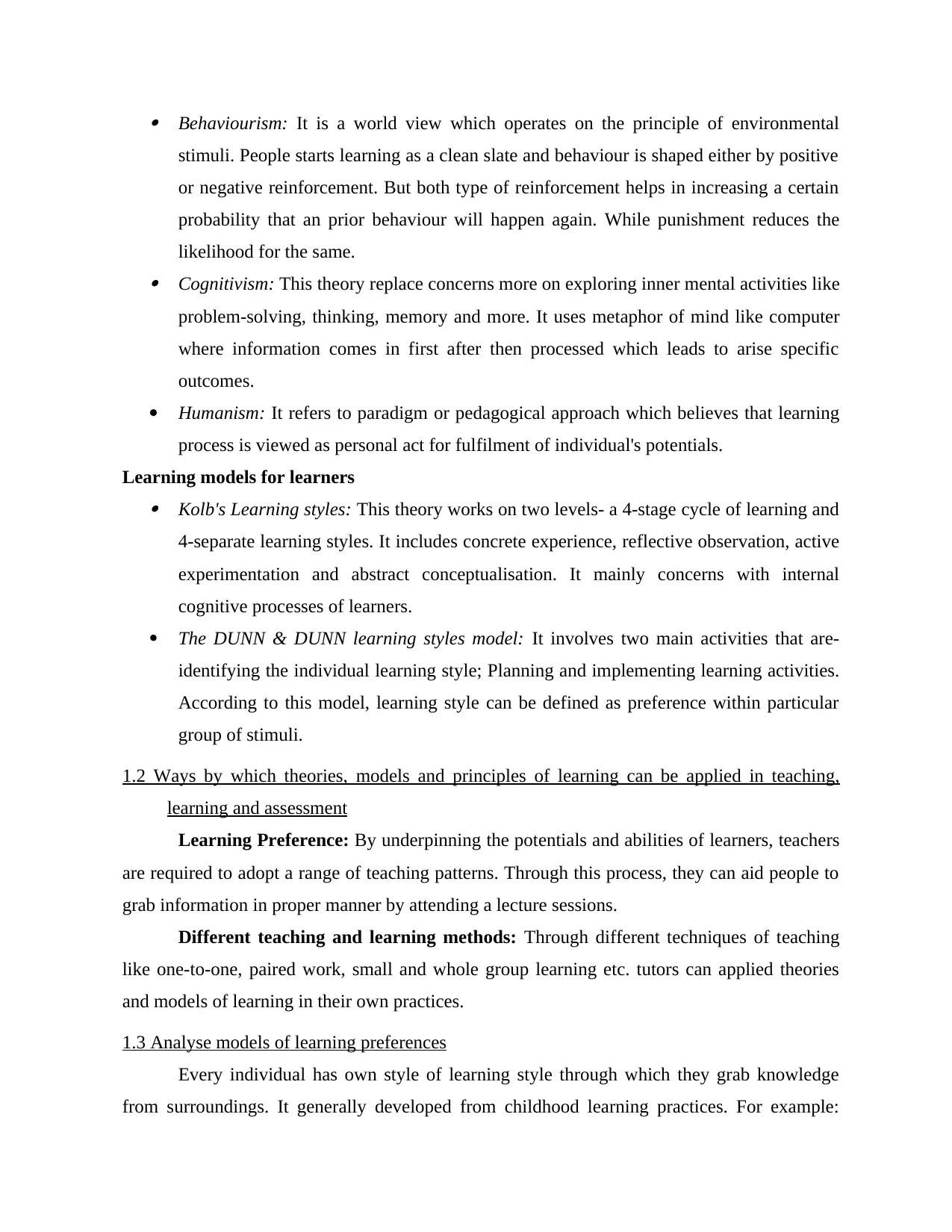
Behaviourism: It is a world view which operates on the principle of environmental
stimuli. People starts learning as a clean slate and behaviour is shaped either by positive
or negative reinforcement. But both type of reinforcement helps in increasing a certain
probability that an prior behaviour will happen again. While punishment reduces the
likelihood for the same. Cognitivism: This theory replace concerns more on exploring inner mental activities like
problem-solving, thinking, memory and more. It uses metaphor of mind like computer
where information comes in first after then processed which leads to arise specific
outcomes.
Humanism: It refers to paradigm or pedagogical approach which believes that learning
process is viewed as personal act for fulfilment of individual's potentials.
Learning models for learners Kolb's Learning styles: This theory works on two levels- a 4-stage cycle of learning and
4-separate learning styles. It includes concrete experience, reflective observation, active
experimentation and abstract conceptualisation. It mainly concerns with internal
cognitive processes of learners.
The DUNN & DUNN learning styles model: It involves two main activities that are-
identifying the individual learning style; Planning and implementing learning activities.
According to this model, learning style can be defined as preference within particular
group of stimuli.
1.2 Ways by which theories, models and principles of learning can be applied in teaching,
learning and assessment
Learning Preference: By underpinning the potentials and abilities of learners, teachers
are required to adopt a range of teaching patterns. Through this process, they can aid people to
grab information in proper manner by attending a lecture sessions.
Different teaching and learning methods: Through different techniques of teaching
like one-to-one, paired work, small and whole group learning etc. tutors can applied theories
and models of learning in their own practices.
1.3 Analyse models of learning preferences
Every individual has own style of learning style through which they grab knowledge
from surroundings. It generally developed from childhood learning practices. For example:
stimuli. People starts learning as a clean slate and behaviour is shaped either by positive
or negative reinforcement. But both type of reinforcement helps in increasing a certain
probability that an prior behaviour will happen again. While punishment reduces the
likelihood for the same. Cognitivism: This theory replace concerns more on exploring inner mental activities like
problem-solving, thinking, memory and more. It uses metaphor of mind like computer
where information comes in first after then processed which leads to arise specific
outcomes.
Humanism: It refers to paradigm or pedagogical approach which believes that learning
process is viewed as personal act for fulfilment of individual's potentials.
Learning models for learners Kolb's Learning styles: This theory works on two levels- a 4-stage cycle of learning and
4-separate learning styles. It includes concrete experience, reflective observation, active
experimentation and abstract conceptualisation. It mainly concerns with internal
cognitive processes of learners.
The DUNN & DUNN learning styles model: It involves two main activities that are-
identifying the individual learning style; Planning and implementing learning activities.
According to this model, learning style can be defined as preference within particular
group of stimuli.
1.2 Ways by which theories, models and principles of learning can be applied in teaching,
learning and assessment
Learning Preference: By underpinning the potentials and abilities of learners, teachers
are required to adopt a range of teaching patterns. Through this process, they can aid people to
grab information in proper manner by attending a lecture sessions.
Different teaching and learning methods: Through different techniques of teaching
like one-to-one, paired work, small and whole group learning etc. tutors can applied theories
and models of learning in their own practices.
1.3 Analyse models of learning preferences
Every individual has own style of learning style through which they grab knowledge
from surroundings. It generally developed from childhood learning practices. For example:
Paraphrase This Document
Need a fresh take? Get an instant paraphrase of this document with our AI Paraphraser
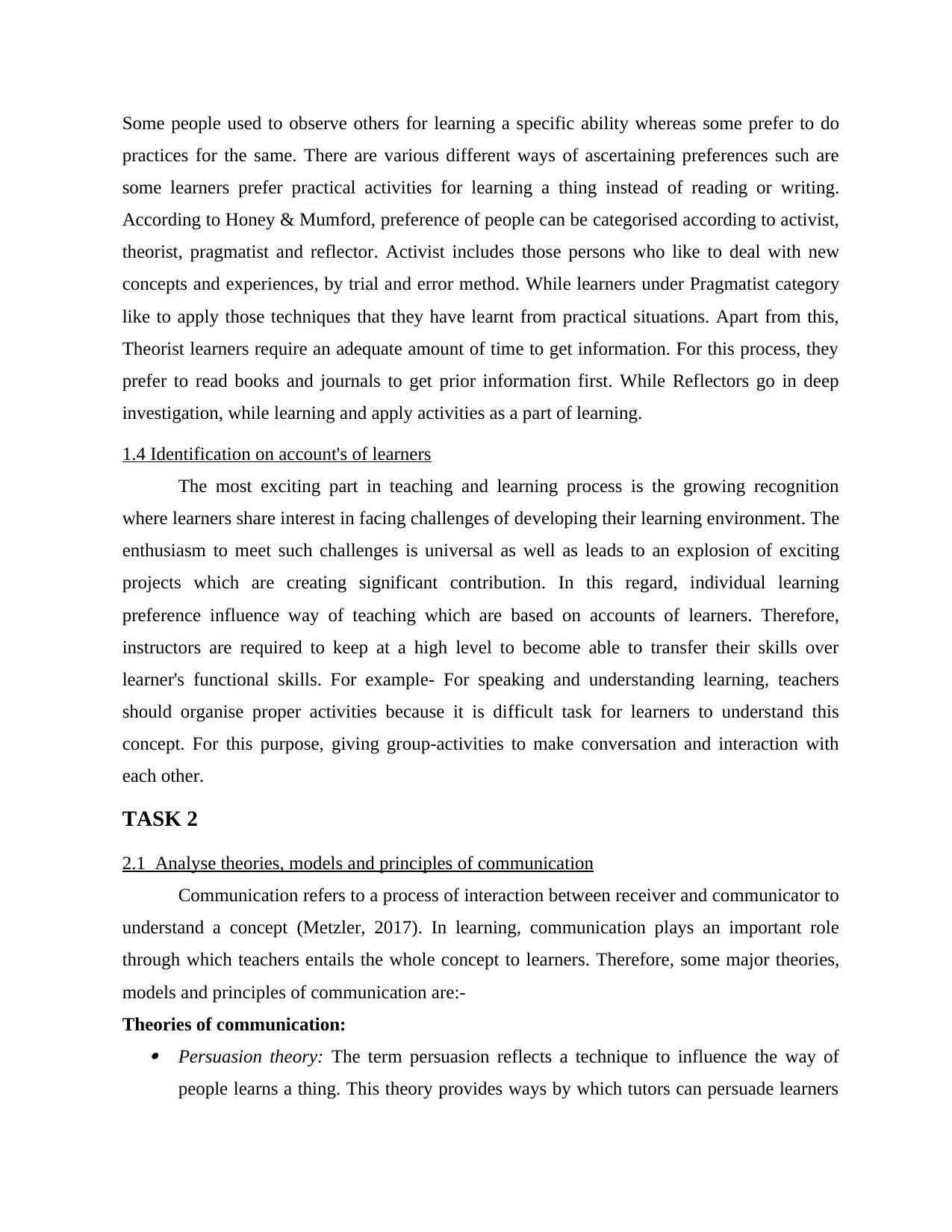
Some people used to observe others for learning a specific ability whereas some prefer to do
practices for the same. There are various different ways of ascertaining preferences such are
some learners prefer practical activities for learning a thing instead of reading or writing.
According to Honey & Mumford, preference of people can be categorised according to activist,
theorist, pragmatist and reflector. Activist includes those persons who like to deal with new
concepts and experiences, by trial and error method. While learners under Pragmatist category
like to apply those techniques that they have learnt from practical situations. Apart from this,
Theorist learners require an adequate amount of time to get information. For this process, they
prefer to read books and journals to get prior information first. While Reflectors go in deep
investigation, while learning and apply activities as a part of learning.
1.4 Identification on account's of learners
The most exciting part in teaching and learning process is the growing recognition
where learners share interest in facing challenges of developing their learning environment. The
enthusiasm to meet such challenges is universal as well as leads to an explosion of exciting
projects which are creating significant contribution. In this regard, individual learning
preference influence way of teaching which are based on accounts of learners. Therefore,
instructors are required to keep at a high level to become able to transfer their skills over
learner's functional skills. For example- For speaking and understanding learning, teachers
should organise proper activities because it is difficult task for learners to understand this
concept. For this purpose, giving group-activities to make conversation and interaction with
each other.
TASK 2
2.1 Analyse theories, models and principles of communication
Communication refers to a process of interaction between receiver and communicator to
understand a concept (Metzler, 2017). In learning, communication plays an important role
through which teachers entails the whole concept to learners. Therefore, some major theories,
models and principles of communication are:-
Theories of communication: Persuasion theory: The term persuasion reflects a technique to influence the way of
people learns a thing. This theory provides ways by which tutors can persuade learners
practices for the same. There are various different ways of ascertaining preferences such are
some learners prefer practical activities for learning a thing instead of reading or writing.
According to Honey & Mumford, preference of people can be categorised according to activist,
theorist, pragmatist and reflector. Activist includes those persons who like to deal with new
concepts and experiences, by trial and error method. While learners under Pragmatist category
like to apply those techniques that they have learnt from practical situations. Apart from this,
Theorist learners require an adequate amount of time to get information. For this process, they
prefer to read books and journals to get prior information first. While Reflectors go in deep
investigation, while learning and apply activities as a part of learning.
1.4 Identification on account's of learners
The most exciting part in teaching and learning process is the growing recognition
where learners share interest in facing challenges of developing their learning environment. The
enthusiasm to meet such challenges is universal as well as leads to an explosion of exciting
projects which are creating significant contribution. In this regard, individual learning
preference influence way of teaching which are based on accounts of learners. Therefore,
instructors are required to keep at a high level to become able to transfer their skills over
learner's functional skills. For example- For speaking and understanding learning, teachers
should organise proper activities because it is difficult task for learners to understand this
concept. For this purpose, giving group-activities to make conversation and interaction with
each other.
TASK 2
2.1 Analyse theories, models and principles of communication
Communication refers to a process of interaction between receiver and communicator to
understand a concept (Metzler, 2017). In learning, communication plays an important role
through which teachers entails the whole concept to learners. Therefore, some major theories,
models and principles of communication are:-
Theories of communication: Persuasion theory: The term persuasion reflects a technique to influence the way of
people learns a thing. This theory provides ways by which tutors can persuade learners
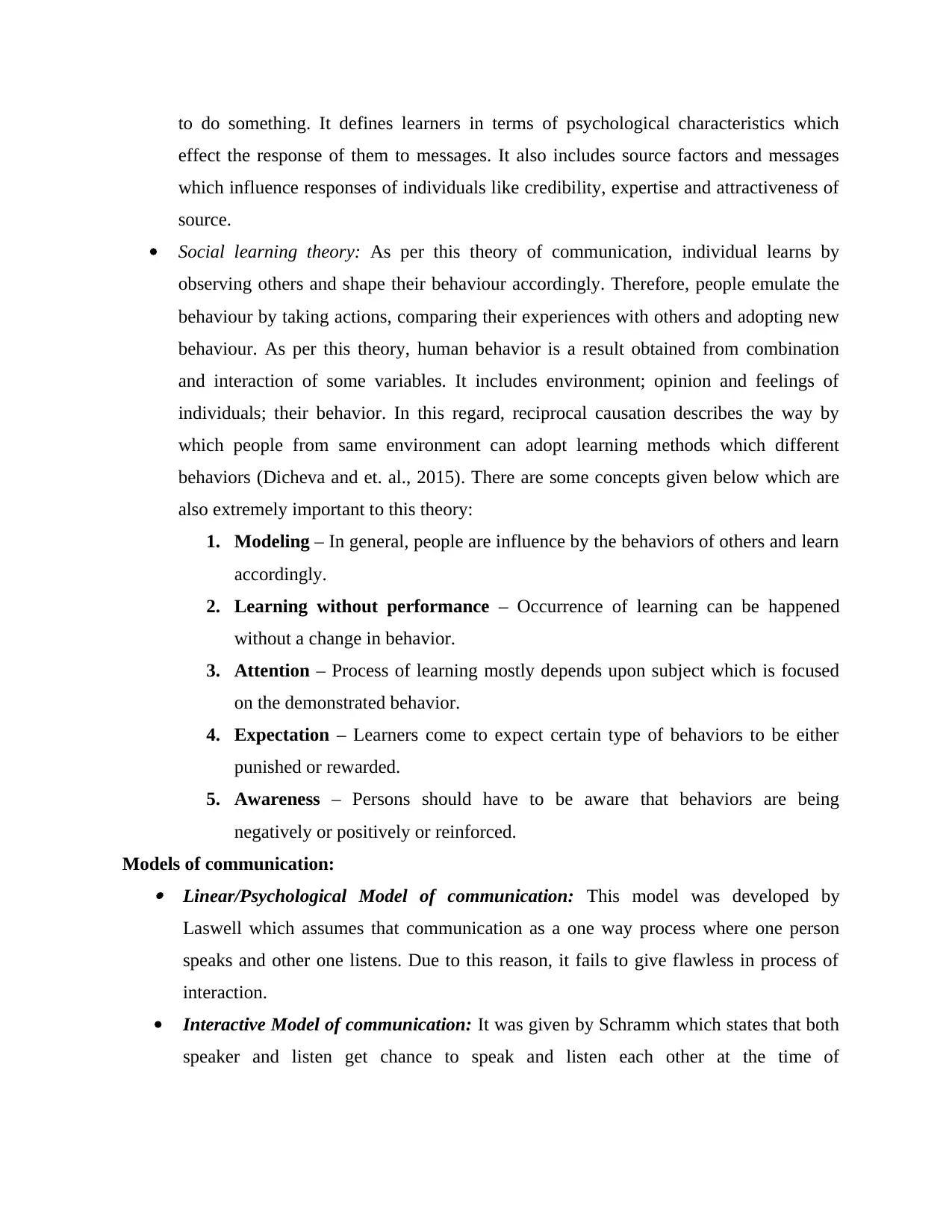
to do something. It defines learners in terms of psychological characteristics which
effect the response of them to messages. It also includes source factors and messages
which influence responses of individuals like credibility, expertise and attractiveness of
source.
Social learning theory: As per this theory of communication, individual learns by
observing others and shape their behaviour accordingly. Therefore, people emulate the
behaviour by taking actions, comparing their experiences with others and adopting new
behaviour. As per this theory, human behavior is a result obtained from combination
and interaction of some variables. It includes environment; opinion and feelings of
individuals; their behavior. In this regard, reciprocal causation describes the way by
which people from same environment can adopt learning methods which different
behaviors (Dicheva and et. al., 2015). There are some concepts given below which are
also extremely important to this theory:
1. Modeling – In general, people are influence by the behaviors of others and learn
accordingly.
2. Learning without performance – Occurrence of learning can be happened
without a change in behavior.
3. Attention – Process of learning mostly depends upon subject which is focused
on the demonstrated behavior.
4. Expectation – Learners come to expect certain type of behaviors to be either
punished or rewarded.
5. Awareness – Persons should have to be aware that behaviors are being
negatively or positively or reinforced.
Models of communication: Linear/Psychological Model of communication: This model was developed by
Laswell which assumes that communication as a one way process where one person
speaks and other one listens. Due to this reason, it fails to give flawless in process of
interaction.
Interactive Model of communication: It was given by Schramm which states that both
speaker and listen get chance to speak and listen each other at the time of
effect the response of them to messages. It also includes source factors and messages
which influence responses of individuals like credibility, expertise and attractiveness of
source.
Social learning theory: As per this theory of communication, individual learns by
observing others and shape their behaviour accordingly. Therefore, people emulate the
behaviour by taking actions, comparing their experiences with others and adopting new
behaviour. As per this theory, human behavior is a result obtained from combination
and interaction of some variables. It includes environment; opinion and feelings of
individuals; their behavior. In this regard, reciprocal causation describes the way by
which people from same environment can adopt learning methods which different
behaviors (Dicheva and et. al., 2015). There are some concepts given below which are
also extremely important to this theory:
1. Modeling – In general, people are influence by the behaviors of others and learn
accordingly.
2. Learning without performance – Occurrence of learning can be happened
without a change in behavior.
3. Attention – Process of learning mostly depends upon subject which is focused
on the demonstrated behavior.
4. Expectation – Learners come to expect certain type of behaviors to be either
punished or rewarded.
5. Awareness – Persons should have to be aware that behaviors are being
negatively or positively or reinforced.
Models of communication: Linear/Psychological Model of communication: This model was developed by
Laswell which assumes that communication as a one way process where one person
speaks and other one listens. Due to this reason, it fails to give flawless in process of
interaction.
Interactive Model of communication: It was given by Schramm which states that both
speaker and listen get chance to speak and listen each other at the time of
⊘ This is a preview!⊘
Do you want full access?
Subscribe today to unlock all pages.

Trusted by 1+ million students worldwide
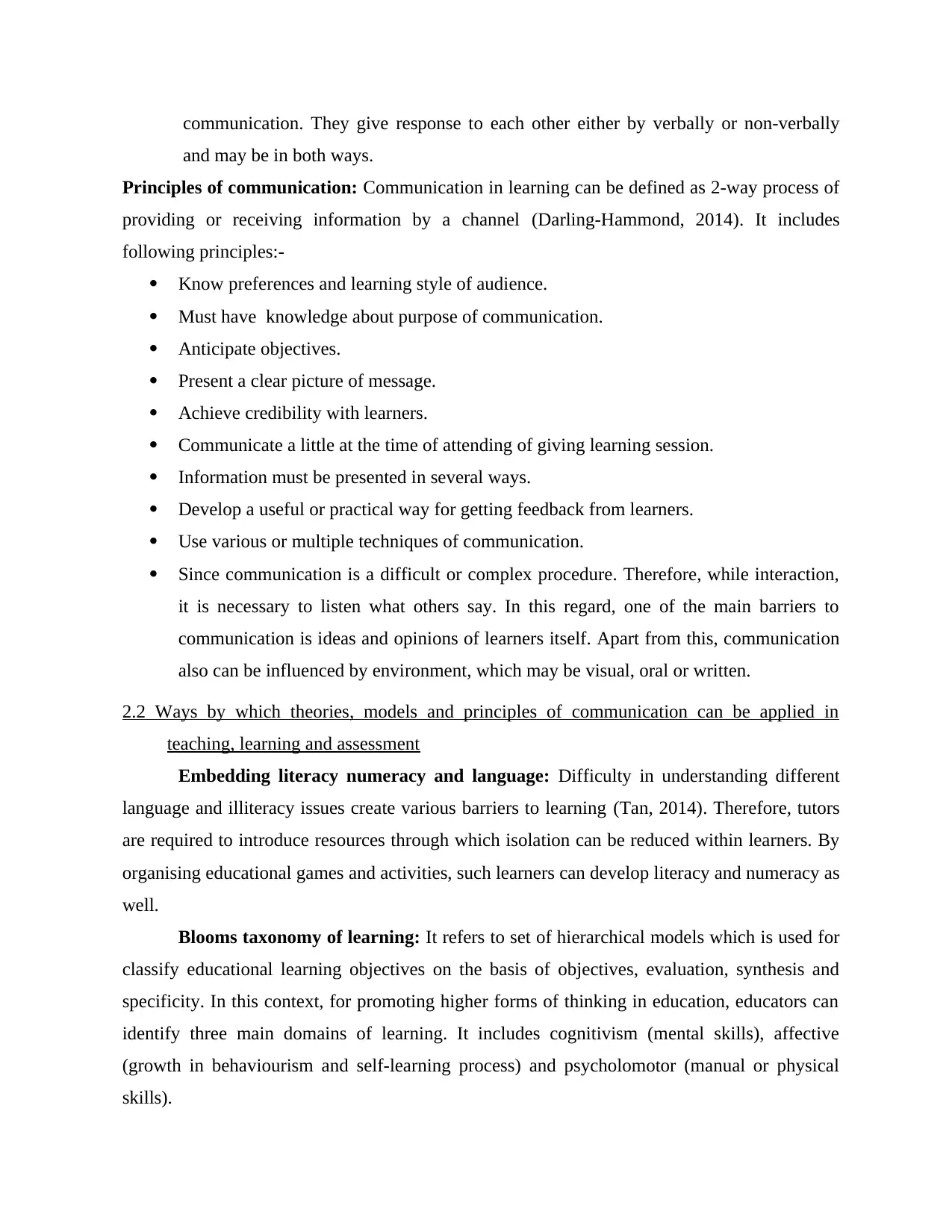
communication. They give response to each other either by verbally or non-verbally
and may be in both ways.
Principles of communication: Communication in learning can be defined as 2-way process of
providing or receiving information by a channel (Darling-Hammond, 2014). It includes
following principles:-
Know preferences and learning style of audience.
Must have knowledge about purpose of communication.
Anticipate objectives.
Present a clear picture of message.
Achieve credibility with learners.
Communicate a little at the time of attending of giving learning session.
Information must be presented in several ways.
Develop a useful or practical way for getting feedback from learners.
Use various or multiple techniques of communication.
Since communication is a difficult or complex procedure. Therefore, while interaction,
it is necessary to listen what others say. In this regard, one of the main barriers to
communication is ideas and opinions of learners itself. Apart from this, communication
also can be influenced by environment, which may be visual, oral or written.
2.2 Ways by which theories, models and principles of communication can be applied in
teaching, learning and assessment
Embedding literacy numeracy and language: Difficulty in understanding different
language and illiteracy issues create various barriers to learning (Tan, 2014). Therefore, tutors
are required to introduce resources through which isolation can be reduced within learners. By
organising educational games and activities, such learners can develop literacy and numeracy as
well.
Blooms taxonomy of learning: It refers to set of hierarchical models which is used for
classify educational learning objectives on the basis of objectives, evaluation, synthesis and
specificity. In this context, for promoting higher forms of thinking in education, educators can
identify three main domains of learning. It includes cognitivism (mental skills), affective
(growth in behaviourism and self-learning process) and psycholomotor (manual or physical
skills).
and may be in both ways.
Principles of communication: Communication in learning can be defined as 2-way process of
providing or receiving information by a channel (Darling-Hammond, 2014). It includes
following principles:-
Know preferences and learning style of audience.
Must have knowledge about purpose of communication.
Anticipate objectives.
Present a clear picture of message.
Achieve credibility with learners.
Communicate a little at the time of attending of giving learning session.
Information must be presented in several ways.
Develop a useful or practical way for getting feedback from learners.
Use various or multiple techniques of communication.
Since communication is a difficult or complex procedure. Therefore, while interaction,
it is necessary to listen what others say. In this regard, one of the main barriers to
communication is ideas and opinions of learners itself. Apart from this, communication
also can be influenced by environment, which may be visual, oral or written.
2.2 Ways by which theories, models and principles of communication can be applied in
teaching, learning and assessment
Embedding literacy numeracy and language: Difficulty in understanding different
language and illiteracy issues create various barriers to learning (Tan, 2014). Therefore, tutors
are required to introduce resources through which isolation can be reduced within learners. By
organising educational games and activities, such learners can develop literacy and numeracy as
well.
Blooms taxonomy of learning: It refers to set of hierarchical models which is used for
classify educational learning objectives on the basis of objectives, evaluation, synthesis and
specificity. In this context, for promoting higher forms of thinking in education, educators can
identify three main domains of learning. It includes cognitivism (mental skills), affective
(growth in behaviourism and self-learning process) and psycholomotor (manual or physical
skills).
Paraphrase This Document
Need a fresh take? Get an instant paraphrase of this document with our AI Paraphraser
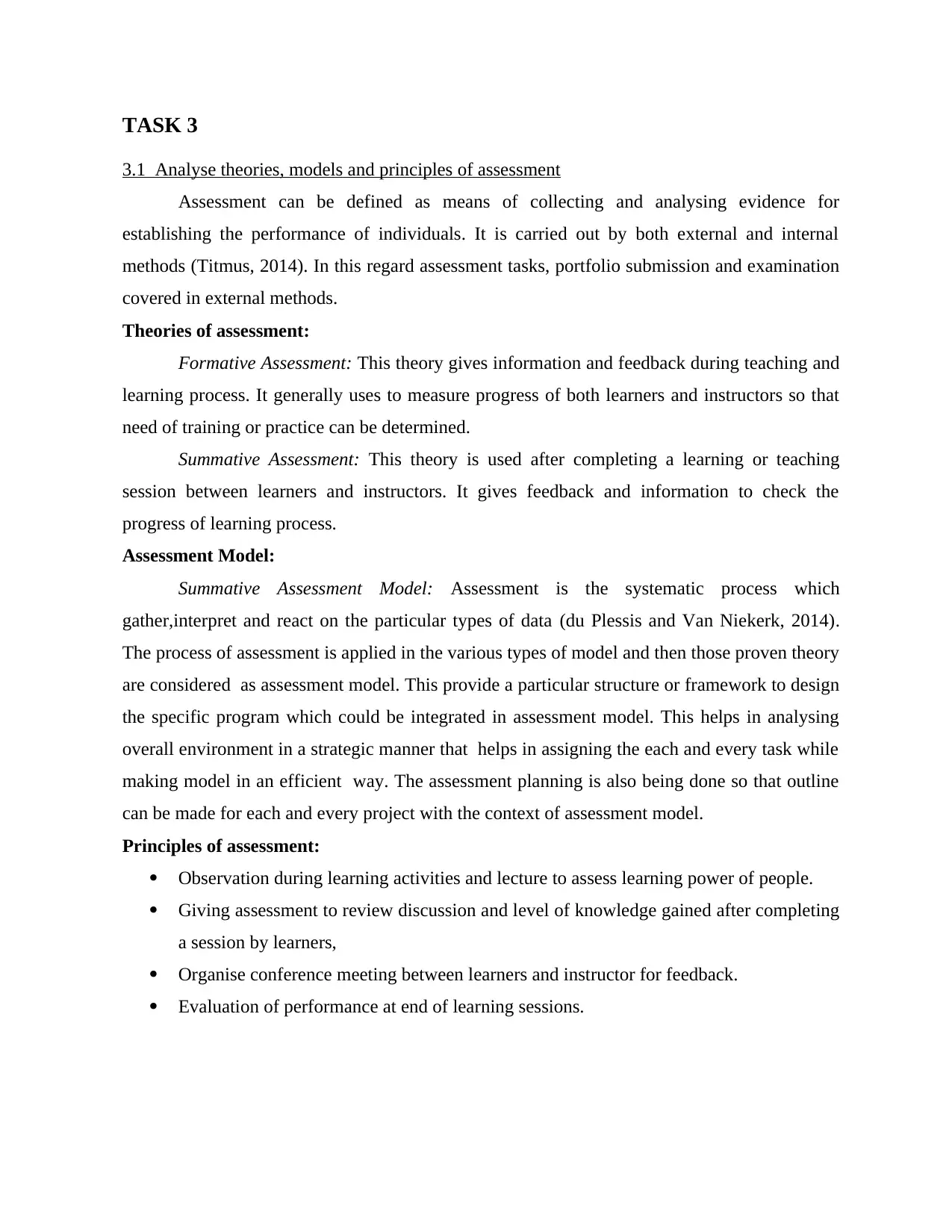
TASK 3
3.1 Analyse theories, models and principles of assessment
Assessment can be defined as means of collecting and analysing evidence for
establishing the performance of individuals. It is carried out by both external and internal
methods (Titmus, 2014). In this regard assessment tasks, portfolio submission and examination
covered in external methods.
Theories of assessment:
Formative Assessment: This theory gives information and feedback during teaching and
learning process. It generally uses to measure progress of both learners and instructors so that
need of training or practice can be determined.
Summative Assessment: This theory is used after completing a learning or teaching
session between learners and instructors. It gives feedback and information to check the
progress of learning process.
Assessment Model:
Summative Assessment Model: Assessment is the systematic process which
gather,interpret and react on the particular types of data (du Plessis and Van Niekerk, 2014).
The process of assessment is applied in the various types of model and then those proven theory
are considered as assessment model. This provide a particular structure or framework to design
the specific program which could be integrated in assessment model. This helps in analysing
overall environment in a strategic manner that helps in assigning the each and every task while
making model in an efficient way. The assessment planning is also being done so that outline
can be made for each and every project with the context of assessment model.
Principles of assessment:
Observation during learning activities and lecture to assess learning power of people.
Giving assessment to review discussion and level of knowledge gained after completing
a session by learners,
Organise conference meeting between learners and instructor for feedback.
Evaluation of performance at end of learning sessions.
3.1 Analyse theories, models and principles of assessment
Assessment can be defined as means of collecting and analysing evidence for
establishing the performance of individuals. It is carried out by both external and internal
methods (Titmus, 2014). In this regard assessment tasks, portfolio submission and examination
covered in external methods.
Theories of assessment:
Formative Assessment: This theory gives information and feedback during teaching and
learning process. It generally uses to measure progress of both learners and instructors so that
need of training or practice can be determined.
Summative Assessment: This theory is used after completing a learning or teaching
session between learners and instructors. It gives feedback and information to check the
progress of learning process.
Assessment Model:
Summative Assessment Model: Assessment is the systematic process which
gather,interpret and react on the particular types of data (du Plessis and Van Niekerk, 2014).
The process of assessment is applied in the various types of model and then those proven theory
are considered as assessment model. This provide a particular structure or framework to design
the specific program which could be integrated in assessment model. This helps in analysing
overall environment in a strategic manner that helps in assigning the each and every task while
making model in an efficient way. The assessment planning is also being done so that outline
can be made for each and every project with the context of assessment model.
Principles of assessment:
Observation during learning activities and lecture to assess learning power of people.
Giving assessment to review discussion and level of knowledge gained after completing
a session by learners,
Organise conference meeting between learners and instructor for feedback.
Evaluation of performance at end of learning sessions.
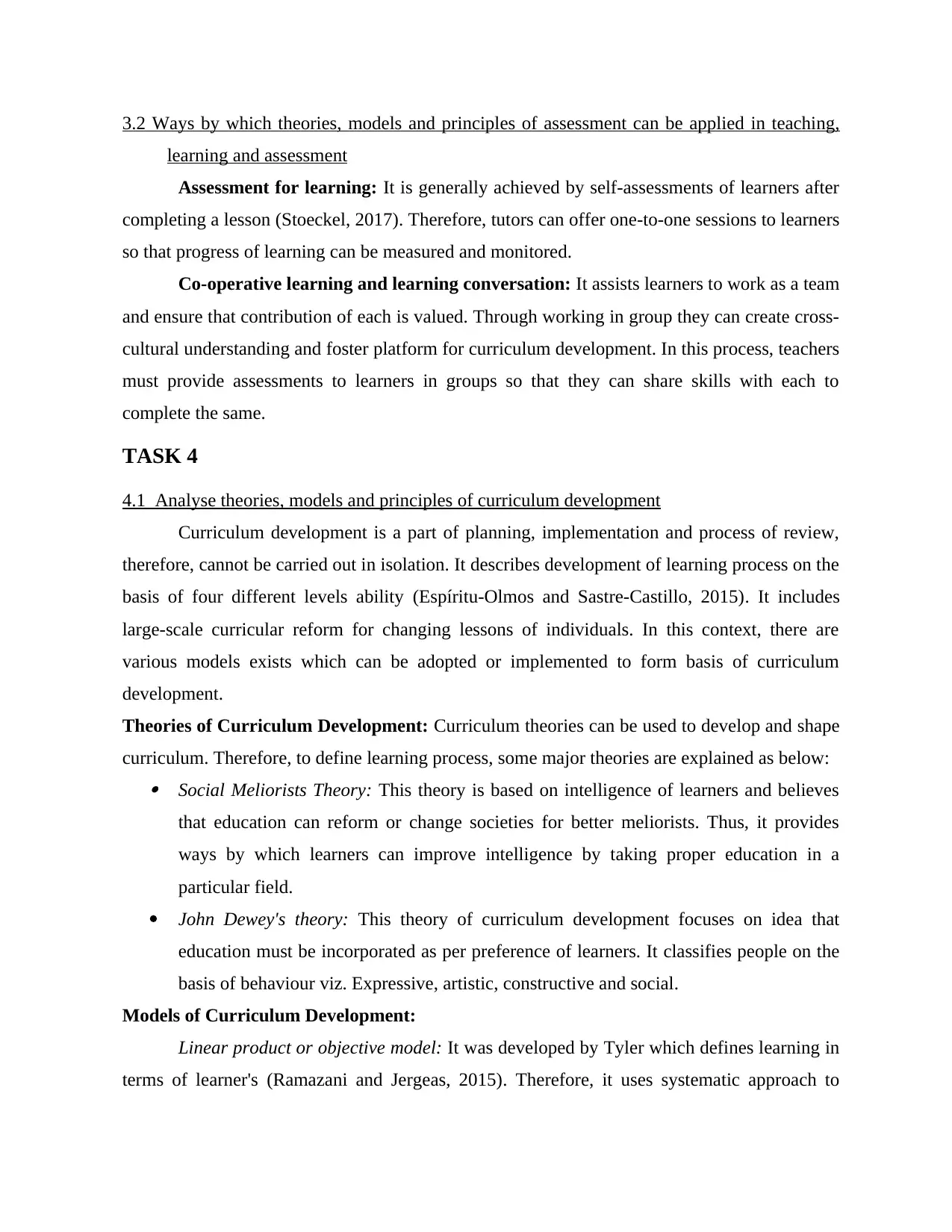
3.2 Ways by which theories, models and principles of assessment can be applied in teaching,
learning and assessment
Assessment for learning: It is generally achieved by self-assessments of learners after
completing a lesson (Stoeckel, 2017). Therefore, tutors can offer one-to-one sessions to learners
so that progress of learning can be measured and monitored.
Co-operative learning and learning conversation: It assists learners to work as a team
and ensure that contribution of each is valued. Through working in group they can create cross-
cultural understanding and foster platform for curriculum development. In this process, teachers
must provide assessments to learners in groups so that they can share skills with each to
complete the same.
TASK 4
4.1 Analyse theories, models and principles of curriculum development
Curriculum development is a part of planning, implementation and process of review,
therefore, cannot be carried out in isolation. It describes development of learning process on the
basis of four different levels ability (Espíritu-Olmos and Sastre-Castillo, 2015). It includes
large-scale curricular reform for changing lessons of individuals. In this context, there are
various models exists which can be adopted or implemented to form basis of curriculum
development.
Theories of Curriculum Development: Curriculum theories can be used to develop and shape
curriculum. Therefore, to define learning process, some major theories are explained as below: Social Meliorists Theory: This theory is based on intelligence of learners and believes
that education can reform or change societies for better meliorists. Thus, it provides
ways by which learners can improve intelligence by taking proper education in a
particular field.
John Dewey's theory: This theory of curriculum development focuses on idea that
education must be incorporated as per preference of learners. It classifies people on the
basis of behaviour viz. Expressive, artistic, constructive and social.
Models of Curriculum Development:
Linear product or objective model: It was developed by Tyler which defines learning in
terms of learner's (Ramazani and Jergeas, 2015). Therefore, it uses systematic approach to
learning and assessment
Assessment for learning: It is generally achieved by self-assessments of learners after
completing a lesson (Stoeckel, 2017). Therefore, tutors can offer one-to-one sessions to learners
so that progress of learning can be measured and monitored.
Co-operative learning and learning conversation: It assists learners to work as a team
and ensure that contribution of each is valued. Through working in group they can create cross-
cultural understanding and foster platform for curriculum development. In this process, teachers
must provide assessments to learners in groups so that they can share skills with each to
complete the same.
TASK 4
4.1 Analyse theories, models and principles of curriculum development
Curriculum development is a part of planning, implementation and process of review,
therefore, cannot be carried out in isolation. It describes development of learning process on the
basis of four different levels ability (Espíritu-Olmos and Sastre-Castillo, 2015). It includes
large-scale curricular reform for changing lessons of individuals. In this context, there are
various models exists which can be adopted or implemented to form basis of curriculum
development.
Theories of Curriculum Development: Curriculum theories can be used to develop and shape
curriculum. Therefore, to define learning process, some major theories are explained as below: Social Meliorists Theory: This theory is based on intelligence of learners and believes
that education can reform or change societies for better meliorists. Thus, it provides
ways by which learners can improve intelligence by taking proper education in a
particular field.
John Dewey's theory: This theory of curriculum development focuses on idea that
education must be incorporated as per preference of learners. It classifies people on the
basis of behaviour viz. Expressive, artistic, constructive and social.
Models of Curriculum Development:
Linear product or objective model: It was developed by Tyler which defines learning in
terms of learner's (Ramazani and Jergeas, 2015). Therefore, it uses systematic approach to
⊘ This is a preview!⊘
Do you want full access?
Subscribe today to unlock all pages.

Trusted by 1+ million students worldwide
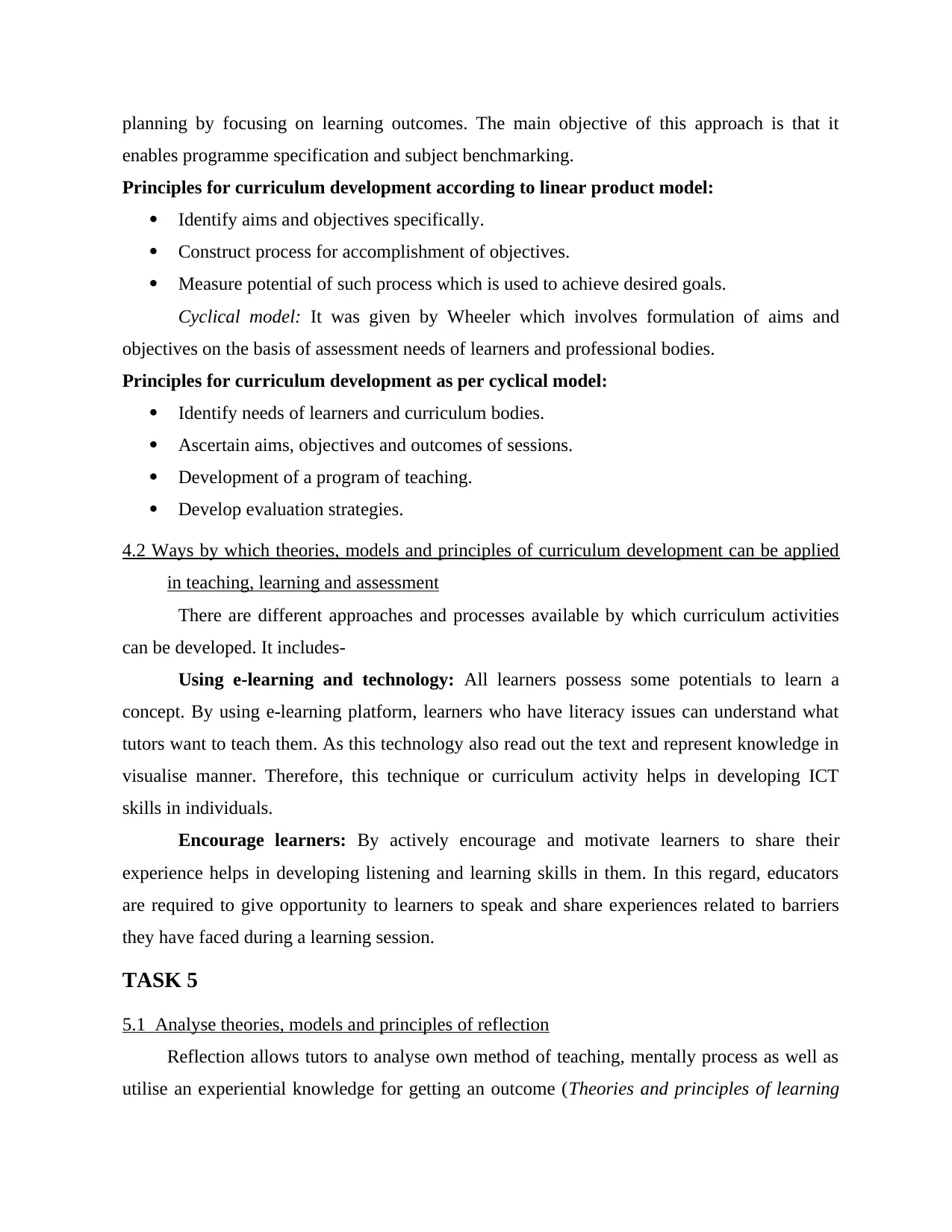
planning by focusing on learning outcomes. The main objective of this approach is that it
enables programme specification and subject benchmarking.
Principles for curriculum development according to linear product model:
Identify aims and objectives specifically.
Construct process for accomplishment of objectives.
Measure potential of such process which is used to achieve desired goals.
Cyclical model: It was given by Wheeler which involves formulation of aims and
objectives on the basis of assessment needs of learners and professional bodies.
Principles for curriculum development as per cyclical model:
Identify needs of learners and curriculum bodies.
Ascertain aims, objectives and outcomes of sessions.
Development of a program of teaching.
Develop evaluation strategies.
4.2 Ways by which theories, models and principles of curriculum development can be applied
in teaching, learning and assessment
There are different approaches and processes available by which curriculum activities
can be developed. It includes-
Using e-learning and technology: All learners possess some potentials to learn a
concept. By using e-learning platform, learners who have literacy issues can understand what
tutors want to teach them. As this technology also read out the text and represent knowledge in
visualise manner. Therefore, this technique or curriculum activity helps in developing ICT
skills in individuals.
Encourage learners: By actively encourage and motivate learners to share their
experience helps in developing listening and learning skills in them. In this regard, educators
are required to give opportunity to learners to speak and share experiences related to barriers
they have faced during a learning session.
TASK 5
5.1 Analyse theories, models and principles of reflection
Reflection allows tutors to analyse own method of teaching, mentally process as well as
utilise an experiential knowledge for getting an outcome (Theories and principles of learning
enables programme specification and subject benchmarking.
Principles for curriculum development according to linear product model:
Identify aims and objectives specifically.
Construct process for accomplishment of objectives.
Measure potential of such process which is used to achieve desired goals.
Cyclical model: It was given by Wheeler which involves formulation of aims and
objectives on the basis of assessment needs of learners and professional bodies.
Principles for curriculum development as per cyclical model:
Identify needs of learners and curriculum bodies.
Ascertain aims, objectives and outcomes of sessions.
Development of a program of teaching.
Develop evaluation strategies.
4.2 Ways by which theories, models and principles of curriculum development can be applied
in teaching, learning and assessment
There are different approaches and processes available by which curriculum activities
can be developed. It includes-
Using e-learning and technology: All learners possess some potentials to learn a
concept. By using e-learning platform, learners who have literacy issues can understand what
tutors want to teach them. As this technology also read out the text and represent knowledge in
visualise manner. Therefore, this technique or curriculum activity helps in developing ICT
skills in individuals.
Encourage learners: By actively encourage and motivate learners to share their
experience helps in developing listening and learning skills in them. In this regard, educators
are required to give opportunity to learners to speak and share experiences related to barriers
they have faced during a learning session.
TASK 5
5.1 Analyse theories, models and principles of reflection
Reflection allows tutors to analyse own method of teaching, mentally process as well as
utilise an experiential knowledge for getting an outcome (Theories and principles of learning
Paraphrase This Document
Need a fresh take? Get an instant paraphrase of this document with our AI Paraphraser
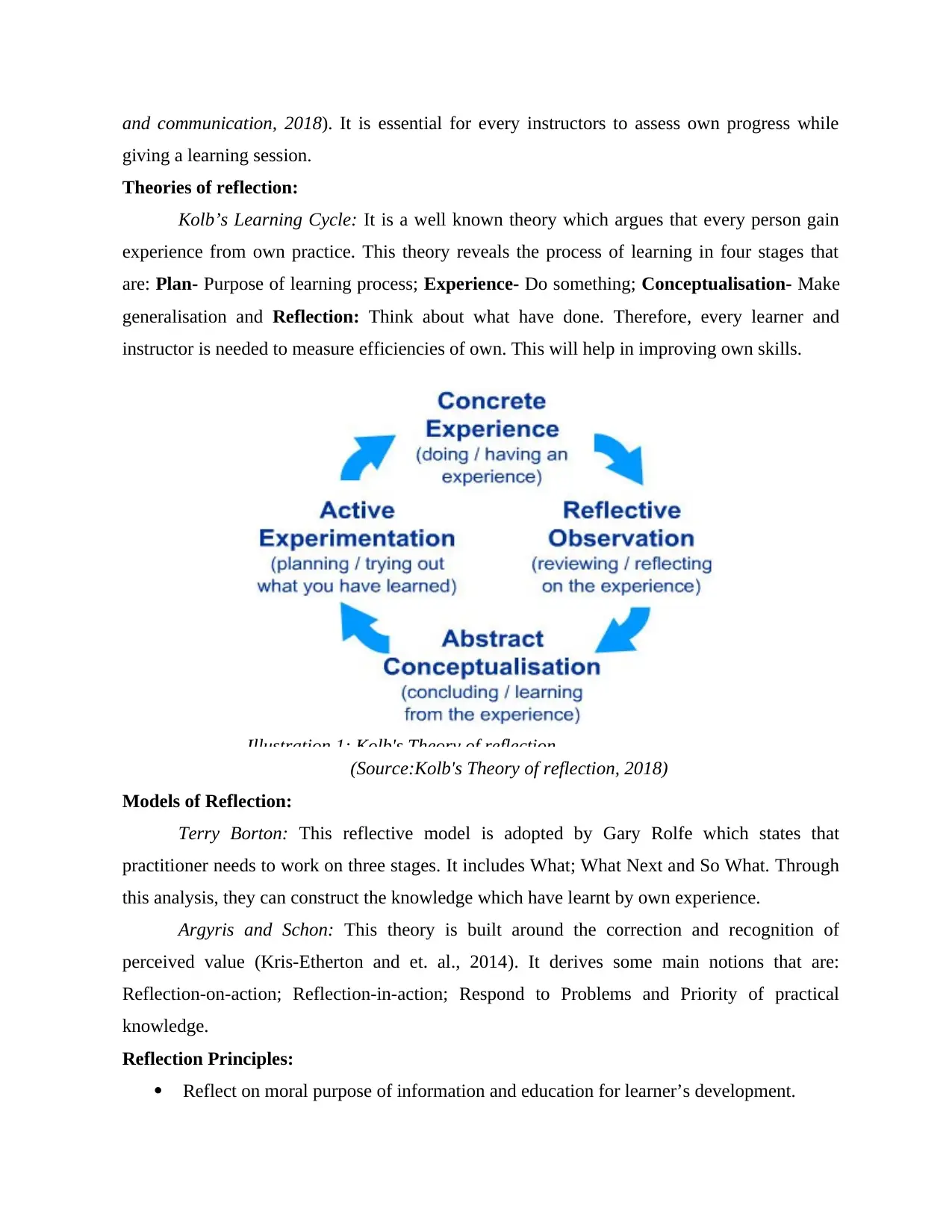
and communication, 2018). It is essential for every instructors to assess own progress while
giving a learning session.
Theories of reflection:
Kolb’s Learning Cycle: It is a well known theory which argues that every person gain
experience from own practice. This theory reveals the process of learning in four stages that
are: Plan- Purpose of learning process; Experience- Do something; Conceptualisation- Make
generalisation and Reflection: Think about what have done. Therefore, every learner and
instructor is needed to measure efficiencies of own. This will help in improving own skills.
(Source:Kolb's Theory of reflection, 2018)
Models of Reflection:
Terry Borton: This reflective model is adopted by Gary Rolfe which states that
practitioner needs to work on three stages. It includes What; What Next and So What. Through
this analysis, they can construct the knowledge which have learnt by own experience.
Argyris and Schon: This theory is built around the correction and recognition of
perceived value (Kris-Etherton and et. al., 2014). It derives some main notions that are:
Reflection-on-action; Reflection-in-action; Respond to Problems and Priority of practical
knowledge.
Reflection Principles:
Reflect on moral purpose of information and education for learner’s development.
Illustration 1: Kolb's Theory of reflection
giving a learning session.
Theories of reflection:
Kolb’s Learning Cycle: It is a well known theory which argues that every person gain
experience from own practice. This theory reveals the process of learning in four stages that
are: Plan- Purpose of learning process; Experience- Do something; Conceptualisation- Make
generalisation and Reflection: Think about what have done. Therefore, every learner and
instructor is needed to measure efficiencies of own. This will help in improving own skills.
(Source:Kolb's Theory of reflection, 2018)
Models of Reflection:
Terry Borton: This reflective model is adopted by Gary Rolfe which states that
practitioner needs to work on three stages. It includes What; What Next and So What. Through
this analysis, they can construct the knowledge which have learnt by own experience.
Argyris and Schon: This theory is built around the correction and recognition of
perceived value (Kris-Etherton and et. al., 2014). It derives some main notions that are:
Reflection-on-action; Reflection-in-action; Respond to Problems and Priority of practical
knowledge.
Reflection Principles:
Reflect on moral purpose of information and education for learner’s development.
Illustration 1: Kolb's Theory of reflection
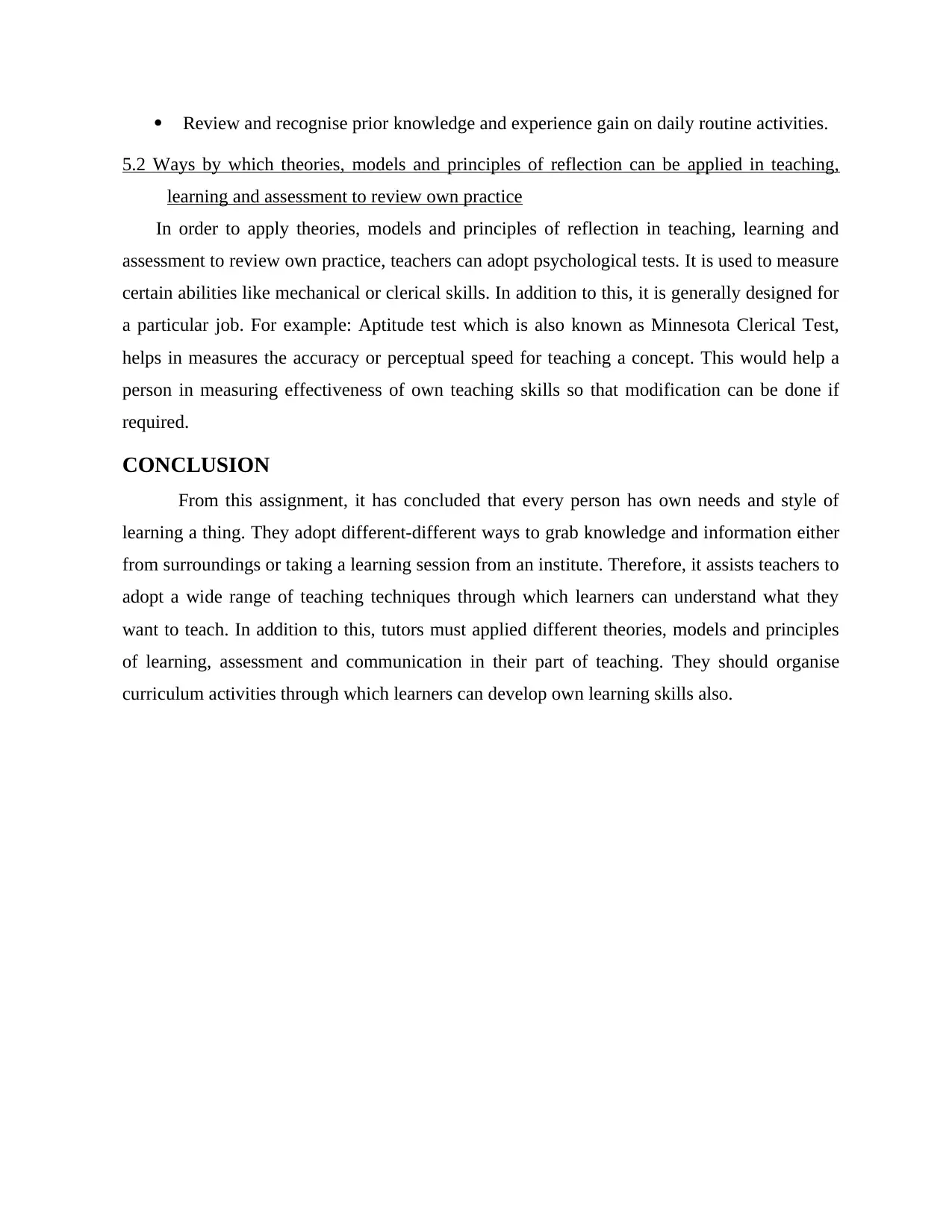
Review and recognise prior knowledge and experience gain on daily routine activities.
5.2 Ways by which theories, models and principles of reflection can be applied in teaching,
learning and assessment to review own practice
In order to apply theories, models and principles of reflection in teaching, learning and
assessment to review own practice, teachers can adopt psychological tests. It is used to measure
certain abilities like mechanical or clerical skills. In addition to this, it is generally designed for
a particular job. For example: Aptitude test which is also known as Minnesota Clerical Test,
helps in measures the accuracy or perceptual speed for teaching a concept. This would help a
person in measuring effectiveness of own teaching skills so that modification can be done if
required.
CONCLUSION
From this assignment, it has concluded that every person has own needs and style of
learning a thing. They adopt different-different ways to grab knowledge and information either
from surroundings or taking a learning session from an institute. Therefore, it assists teachers to
adopt a wide range of teaching techniques through which learners can understand what they
want to teach. In addition to this, tutors must applied different theories, models and principles
of learning, assessment and communication in their part of teaching. They should organise
curriculum activities through which learners can develop own learning skills also.
5.2 Ways by which theories, models and principles of reflection can be applied in teaching,
learning and assessment to review own practice
In order to apply theories, models and principles of reflection in teaching, learning and
assessment to review own practice, teachers can adopt psychological tests. It is used to measure
certain abilities like mechanical or clerical skills. In addition to this, it is generally designed for
a particular job. For example: Aptitude test which is also known as Minnesota Clerical Test,
helps in measures the accuracy or perceptual speed for teaching a concept. This would help a
person in measuring effectiveness of own teaching skills so that modification can be done if
required.
CONCLUSION
From this assignment, it has concluded that every person has own needs and style of
learning a thing. They adopt different-different ways to grab knowledge and information either
from surroundings or taking a learning session from an institute. Therefore, it assists teachers to
adopt a wide range of teaching techniques through which learners can understand what they
want to teach. In addition to this, tutors must applied different theories, models and principles
of learning, assessment and communication in their part of teaching. They should organise
curriculum activities through which learners can develop own learning skills also.
⊘ This is a preview!⊘
Do you want full access?
Subscribe today to unlock all pages.

Trusted by 1+ million students worldwide
1 out of 13
Related Documents
Your All-in-One AI-Powered Toolkit for Academic Success.
+13062052269
info@desklib.com
Available 24*7 on WhatsApp / Email
![[object Object]](/_next/static/media/star-bottom.7253800d.svg)
Unlock your academic potential
Copyright © 2020–2025 A2Z Services. All Rights Reserved. Developed and managed by ZUCOL.